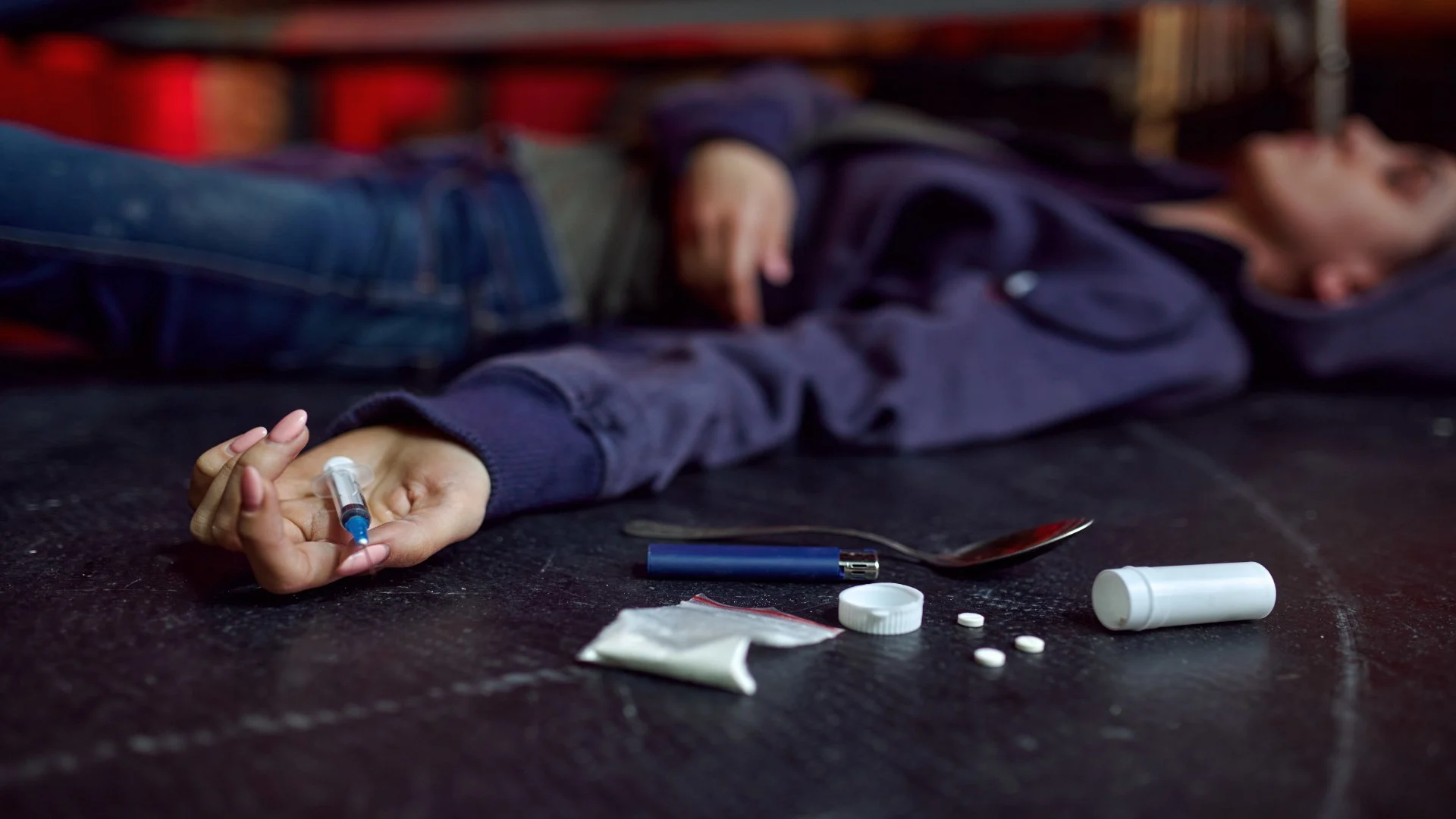Drug and Alcohol
Understanding Opioid Overdose

Learn about opioid overdose, its risks, and how recovery is possible. Discover a path to healing and hope for those affected by opioid overdose and addiction.
What are the Primary Causes of Opioid Overdose?
Overdose can be caused by high opioid tolerance, mixing substances like alcohol or benzodiazepines, and access to potent opioids like fentanyl. These factors increase the risk of respiratory depression, leading to overdose, often with fatal consequences.
How Can I Recognize if Someone is Experiencing an Opioid Overdose?
Signs of an overdose include unresponsiveness, slow or irregular breathing, and pinpoint pupils. These symptoms occur due to the depressant effects of opioids on the brain, particularly on the respiratory system, leading to a life-threatening emergency.
What Should I Do if I Suspect Someone Has Overdosed?
If you suspect an overdose, call emergency services immediately. Administer naloxone, if available, to reverse the overdose effects. If needed, perform rescue breathing or CPR and stay with the person, monitoring their condition until medical help arrives.
What Treatment Options are Available for Opioid Use Disorder?
Treatment options for opioid use disorder include medication-assisted treatment (MAT), therapy (like CBT), and peer support groups. MAT uses medications to reduce cravings, while therapy addresses the psychological aspect of addiction, helping individuals recover and maintain long-term sobriety.
How Can Families Support a Loved One Recovering from Opioid Addiction?
Families can support recovery by providing emotional support, understanding the recovery process, and seeking family counseling. Compassion, open communication, and patience help loved ones overcome challenges, rebuild relationships, and create a positive environment for long-term recovery.
Opioid overdose is a frightening and dangerous reality for many individuals and their families. If you or someone you love faces this crisis, it can feel overwhelming and hopeless. The constant fear of overdose can overshadow the possibility of recovery.
However, the truth is that there is hope. With the proper support and treatment, recovery from opioid addiction is possible. In this article, we’ll explore the signs of overdose, the path to healing, and how you can take the first step toward a healthier, brighter future.
Recognizing Opioid Overdose
Opioid overdose is a medical emergency that can occur when someone takes more opioids than their body can handle, leading to life-threatening consequences. Recognizing the signs and symptoms of overdose is crucial, as early intervention can save lives. Below are the common signs and symptoms to look for:
Common Signs and Symptoms of Overdose
Unresponsiveness or Loss of Consciousness
One of the most prominent signs of an overdose is unresponsiveness. A person experiencing an overdose may become extremely drowsy or fall unconscious and cannot be awakened. This is due to the central nervous system's depression caused by the opioids.
Slow or Irregular Breathing
Opioids depress the brain's respiratory centers, leading to slowed breathing or even complete cessation of breathing. If a person’s breathing becomes very slow, shallow, or stops altogether, it is a serious warning sign of overdose.
Pinpoint Pupils
Opioids constrict the pupils, often leading to pinpoint pupils, which is one of the classic signs of an overdose. The smaller the pupils, the more severe the overdose may be.
Blue or Pale Skin
Reduced oxygen levels in the blood caused by slowed or stopped breathing can lead to a bluish tint on the lips, face, or extremities. The skin may also appear pale or clammy, signaling the body lacks oxygen.
Cold or Clammy Skin
Opioid overdose can cause the skin to become cold and damp due to shock, a state where the body's systems are failing to maintain normal function. This symptom, alongside others, can be a red flag for overdose.
Weak Pulse or Low Blood Pressure
A weak or slow pulse, coupled with a drop in blood pressure, can occur during an overdose. This happens because opioids depress the body's cardiovascular system, leading to reduced circulation.

We’re Here To Help You Find Your Way
Would you like more information about opioid overdose? Reach out today.
Physiological Mechanisms Leading to Opioid Overdose
Understanding how opioid overdose occurs can provide insight into why these signs and symptoms appear.
Central Nervous System Depression
Opioids act on the brain and spinal cord by binding to specific receptors known as opioid receptors.
These receptors are part of the body’s pain relief and reward systems. However, when opioids are taken in excessive amounts, they begin to depress the central nervous system (CNS), including areas that control breathing, heart rate, and consciousness.
Respiratory Depression

One of the most dangerous effects of opioids is their ability to slow or stop breathing. When opioids bind to receptors in the brainstem, which controls automatic processes like breathing and heart rate, it inhibits the body’s ability to regulate these vital functions.
This can result in extremely slow or shallow breathing (respiratory depression) and, in severe cases, respiratory arrest (when breathing stops completely).
Reduced Oxygen Supply to the Brain and Body
When breathing slows or stops, the body becomes deprived of oxygen, which can cause the brain and other vital organs to lack oxygen.
This is why blue or pale skin and unconsciousness often occur during an overdose. Without immediate intervention, oxygen deprivation can lead to brain damage or death.
Disruption of Circulation
In addition to respiratory depression, opioids can cause low blood pressure and a slow heart rate. This results from the depressive effects on the cardiovascular system.
As the heart pumps less effectively and the blood vessels dilate, blood flow to the brain and other organs is reduced, contributing to the weak pulse and cold, clammy skin observed during an overdose.
Toxicity From Excessive Drug Concentration
When a person uses opioids, especially when mixing them with other substances (e.g., alcohol, benzodiazepines, or illicit drugs like heroin), the risk of overdose increases; the body can only metabolize a certain amount of the drug at a time.
When someone consumes a dose beyond their body’s ability to process it, the concentration of the drug in the bloodstream rises to toxic levels. This toxicity overwhelms the body’s systems and leads to overdose.
Immediate Response to Opioid Overdose
Witnessing an overdose can be a terrifying experience, but quick action can make a life-saving difference. Understanding the immediate steps to take and the role of naloxone in reversing an overdose can help reduce the risk of severe consequences and improve the chances of recovery.
Steps to Take if Witnessing an Overdose
Call Emergency Services Immediately
The first and most crucial step is to call emergency services (911 or the equivalent in your location). Overdoses are medical emergencies that require immediate attention.
Be clear and specific when describing the situation to the dispatcher, mentioning that the person is overdosing and exhibiting symptoms like unresponsiveness, slow or stopped breathing, or pinpoint pupils. This will allow first responders to prepare the necessary medical treatment.
Try to Wake the Person
If the person is unresponsive, attempt to wake them by calling their name and gently shaking their shoulders. If the person does not respond, it may be an indication of a severe overdose. Never assume the person is just asleep – prompt medical intervention is needed.
Administer Naloxone (Narcan) if Available
Naloxone is a medication that can reverse the effects of an overdose, particularly respiratory depression. If you have naloxone available, administer it immediately.
Naloxone comes in both injectable and nasal spray forms, and it is a critical tool in emergency overdose situations. It works by binding to opioid receptors in the brain, reversing respiratory depression and other life-threatening symptoms caused by opioids.
Nasal Spray (Narcan): Remove the cap, insert the nozzle into one of the person’s nostrils, and press the plunger. One spray is usually sufficient, but a second dose can be administered if the person does not respond after 2-3 minutes.
Injection: If using an injectable form, follow the directions carefully and inject naloxone into the person’s thigh or upper arm. Sometimes, a second dose may be required if there is no response within 2 to 3 minutes.
Perform Rescue Breathing or CPR if Needed.
If the person is not breathing or has slow, shallow breathing, performing rescue breathing or CPR is essential. Sometimes, mouth-to-mouth resuscitation may be necessary to help deliver oxygen.
If you're not trained in CPR, follow the dispatcher’s instructions over the phone. CPR can help sustain oxygen flow to the brain and vital organs while waiting for professional help.
Monitor the Person's Condition
After administering naloxone and performing rescue breathing or CPR (if necessary), monitor the person closely. If they start to breathe independently or regain consciousness, ensure they remain awake and alert. Keep them sitting or lying down and calm while waiting for emergency responders.

We’ll Lead You to New Heights
Do you have more questions about opioid overdose? Reach out.
The Path to Recovery
Surviving an overdose is just the first step toward healing, but the journey to recovery comes with its own set of challenges. These can include physical withdrawal symptoms, emotional struggles like guilt or anxiety, and a heightened risk of relapse.
Social pressures, such as strained relationships or living in environments where drugs are accessible, can also hinder progress.
The Importance of Comprehensive Treatment Plans
A comprehensive treatment plan is essential for achieving a lasting recovery. It should address the physical, emotional, and psychological aspects of addiction. A holistic approach, encompassing therapy, medication, and long-term support, equips individuals with the necessary tools to rebuild their lives. Ongoing monitoring ensures that any emerging challenges are addressed promptly and effectively.
Treatment Options

Medication-Assisted Treatment (MAT):
MAT combines medications like methadone, buprenorphine, or naltrexone with counseling to reduce cravings and withdrawal symptoms, supporting long-term recovery.
Behavioral Therapy:
Cognitive Behavioral Therapy (CBT), contingency management, and motivational interviewing help individuals address the psychological aspects of addiction and develop healthy coping mechanisms.
Support Groups:
Peer support groups like Narcotics Anonymous (NA) provide a sense of community and accountability, helping individuals stay on track.
Inpatient and Outpatient Programs:
For severe cases, inpatient programs offer intensive care, while outpatient programs provide flexible treatment with continued support.
Opioid Overdose Impacting Your Life? We're Here to Help
Opioid overdose is a serious and often life-threatening event, but recovery is possible with the proper support. At The Edge Treatment Center, we understand your challenges and are here to help you navigate the road to healing.
Our personalized treatment plans combine medical care, therapy, and ongoing support to guide you toward a future free from addiction. You don’t have to face this journey alone—reach out today and take the first step toward a better, healthier life.

We’re Here To Help You Find Your Way
If you or a loved one is struggling with addiction, there is hope. Our team can guide you on your journey to recovery. Call us today.
Written by
The Edge Treatment Center
Reviewed by
 Jeremy Arzt
Jeremy ArztChief Clinical Officer
Drug and Alcohol
June 16, 2025
